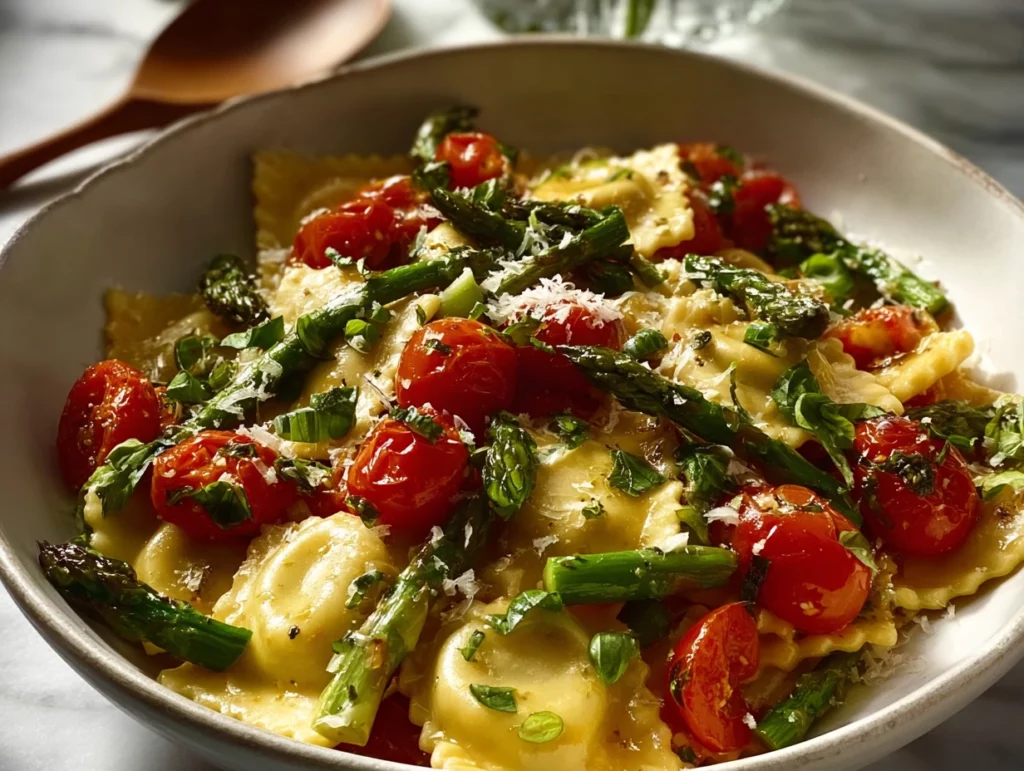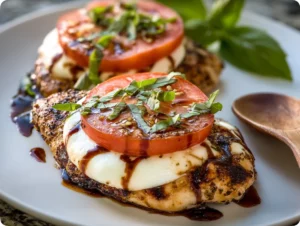There’s just something about a bowl of tender ravioli tossed with seasonal veggies that makes me feel like spring has officially arrived. Even when the calendar says summer, I love bringing in those bright, garden-fresh flavors that remind me of longer days and meals on the patio. This Ravioli with Tomatoes, Asparagus, Garlic, and Herbs is one of those simple, comforting recipes I reach for when I want something quick but still packed with fresh flavor.
This dish is beautifully balanced—cheese-filled ravioli (store-bought or homemade, if you’re feeling fancy) meet juicy cherry tomatoes, tender asparagus, and fragrant garlic, all brought together in a buttery olive oil sauce with plenty of herbs. It’s light, fresh, and just rich enough to feel like something special. And best of all? It comes together in about 20 minutes, making it perfect for a busy weeknight or a relaxed weekend dinner.
I first made this when I had a half-bag of ravioli and some lingering spring produce in the fridge—you know that kind of “what’s left in here” dinner. Turns out, this was one of the most delicious clean-out-the-fridge meals I’ve ever made. And now it’s in regular rotation. Whether you’re cooking for guests or just for yourself, this recipe hits that perfect note between simple and satisfying.
Let’s jump in and get cooking!
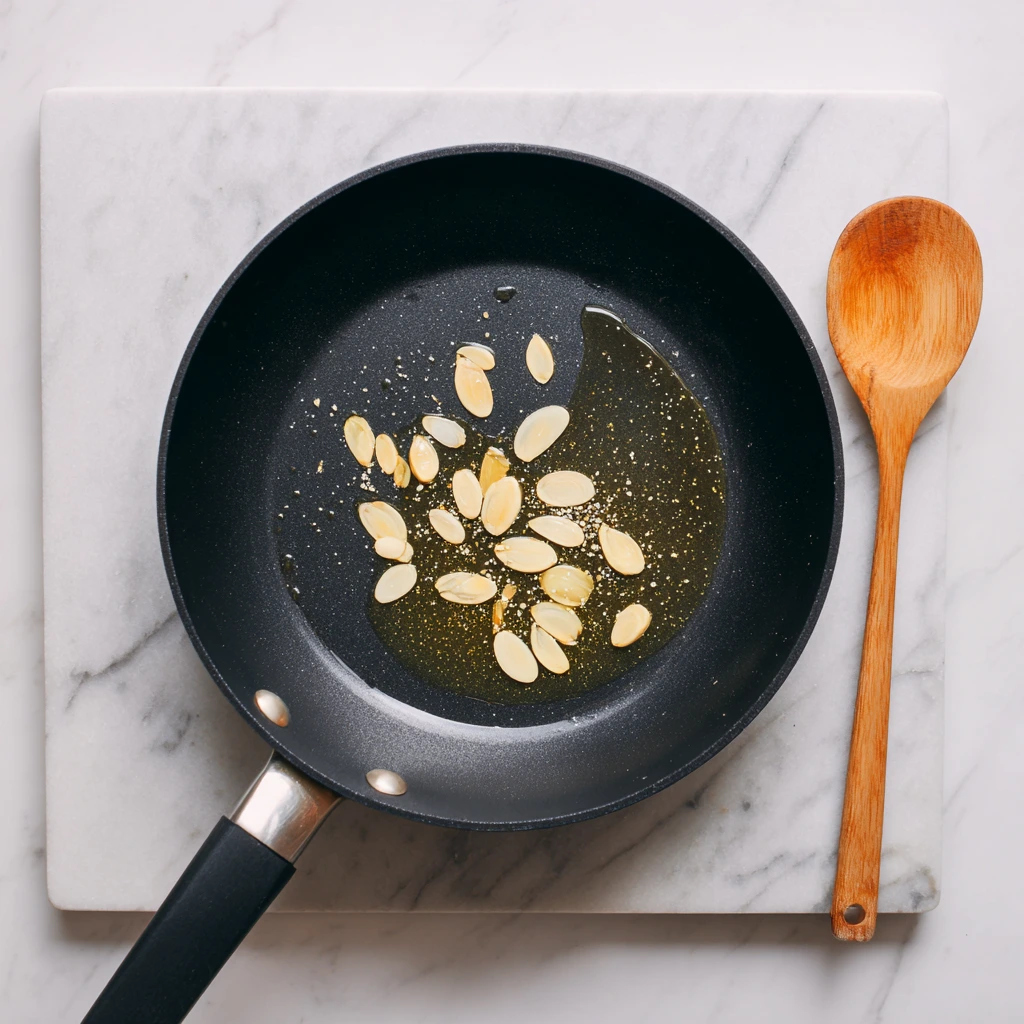
Ingredients You’ll Need
For the pasta:
-
1 pound fresh or refrigerated cheese ravioli
For the vegetable sauté:
-
2 tablespoons extra-virgin olive oil
-
2 tablespoons unsalted butter
-
3 garlic cloves, thinly sliced
-
1 pint cherry tomatoes, halved
-
1 bunch asparagus (about 8 ounces), trimmed and cut into 1-inch pieces
-
Salt and freshly ground black pepper to taste
-
Pinch of red pepper flakes (optional)
For finishing and garnish:
-
¼ cup fresh basil leaves, chiffonade
-
1 tablespoon fresh thyme leaves (or 1 teaspoon dried)
-
½ cup freshly grated Parmesan cheese, plus more for serving
-
Zest of one lemon (optional)
STEP 1: Cook the Ravioli Just Right
Start by bringing a large pot of salted water to a gentle boil. You’ll want a steady bubble here—not a wild, rolling boil that might tear your ravioli apart. Once the water’s ready, drop in the ravioli and cook them just until they float to the top and are al dente. This usually takes about 3-5 minutes for fresh or refrigerated varieties.
Pro Tip: Use a slotted spoon to transfer the ravioli directly into your skillet later—you’ll want to keep some of that pasta water! Go ahead and reserve about a cup of it before you drain the rest. That starchy water is key to creating a silky, light sauce later on.
STEP 2: Sauté the Garlic and Asparagus
While the ravioli are cooking, grab your largest skillet and heat the olive oil and butter over medium heat. When the butter starts to foam just a bit, that’s your cue to add the sliced garlic. Sauté it gently—about 30 seconds—just until it’s fragrant. Be careful not to let it brown, or it’ll get bitter.
Next, toss in your asparagus pieces. Cook them for 2 to 3 minutes until they start to soften, but still have a little snap. You want that tender-crisp bite—it adds texture and makes the dish feel extra fresh.
STEP 3: Add the Cherry Tomatoes and Season
Time to bring in the juicy sweetness! Stir in your halved cherry tomatoes and season everything with salt, black pepper, and a pinch of red pepper flakes if you like a little heat. Let the tomatoes cook for about 3 more minutes, just until they begin to break down and release some of their juices. This helps form the base of your sauce and coats the veggies in a natural sweetness.
If you’re using a nonstick pan or a lighter skillet, you might not see a lot of fond (that golden brown goodness on the bottom), but if you’re working with stainless steel, this is the point where a splash of dry white wine (maybe 2-3 tablespoons) can help deglaze the pan. Totally optional, but it adds a nice depth if you’ve got a bottle open.
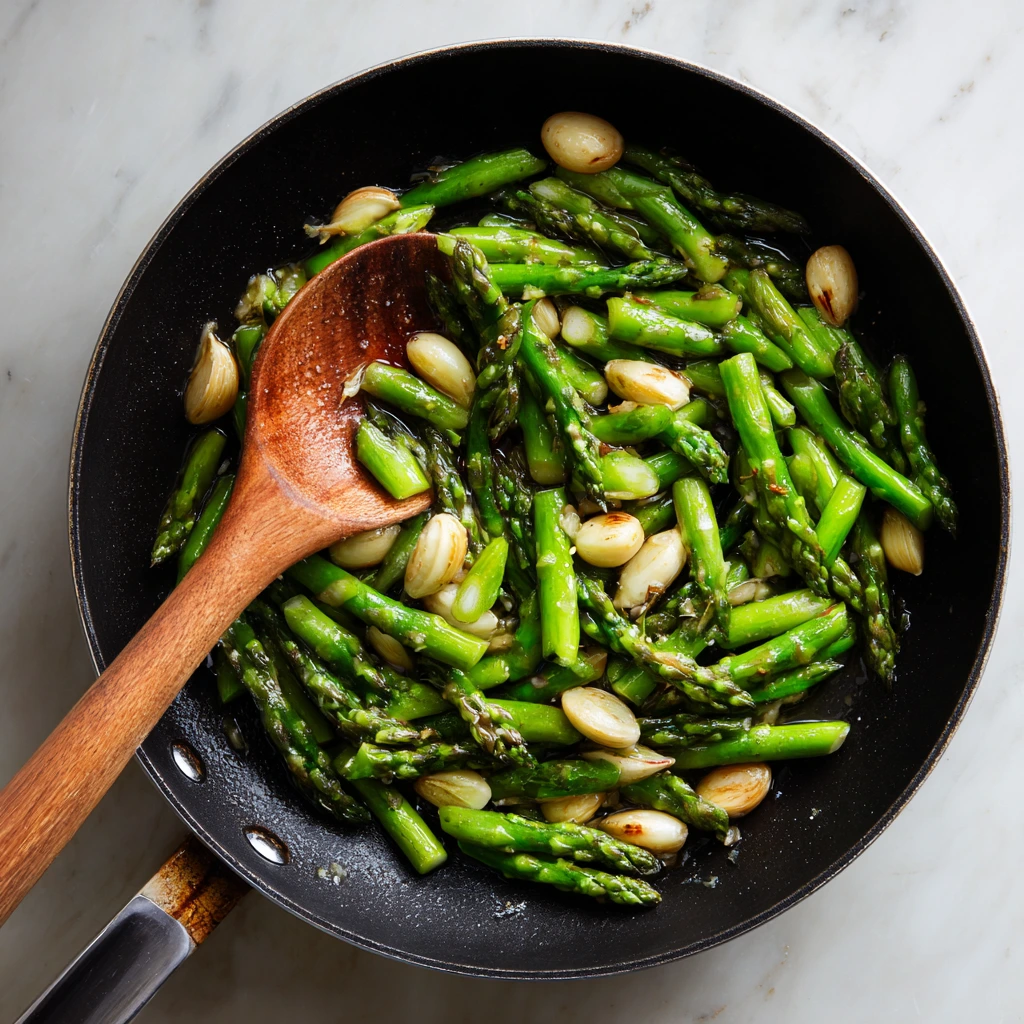
Finishing the Ravioli with Herbs, Parmesan, and a Touch of Lemon
Now that we’ve got our ravioli cooked and our veggies sautéed to perfection, it’s time to pull everything together into one light, flavorful, and utterly satisfying dish. This is where the magic happens—fresh herbs, a touch of lemon zest, and a generous grating of Parmesan take this from weeknight-easy to dinner-party-worthy.
Whether you’re cooking for family, guests, or just enjoying a quiet meal on your own, the finishing touches here make all the difference. And don’t worry—it’s as easy as tossing everything together and letting the ingredients shine. Let’s get right back into it.
STEP 4: Combine the Ravioli and Vegetables
At this point, your ravioli should be floating and ready, and your asparagus and tomatoes should be tender and glistening in garlicky olive oil. Using a slotted spoon, gently transfer the ravioli from the pot into the skillet with the vegetables. Be sure to add them carefully to avoid tearing.
Give everything a soft toss to coat the ravioli in the tomato and garlic mixture. This is where that reserved pasta water can come in handy—if your pan is looking a little dry, add a splash (start with a tablespoon or two) to loosen things up and create a light, silky sauce that clings to every bite.
You’re not looking for a heavy sauce here—just enough to bring everything together and carry the flavor.
STEP 5: Stir in the Herbs and Lemon Zest
Once everything is tossed together and warmed through, go ahead and take the skillet off the heat. Now’s the time to add your fresh herbs—scatter in the chiffonade of basil and the thyme leaves. If you’re using dried thyme, no worries—just sprinkle it in earlier, with the tomatoes, to give it time to soften and release its flavor.
If you want a pop of brightness (I always do), grate in the zest of one lemon. It’s optional, but it lifts the whole dish and complements the creamy cheese inside the ravioli beautifully. That fresh, citrusy note balances the richness and adds a hint of sunshine to every bite.
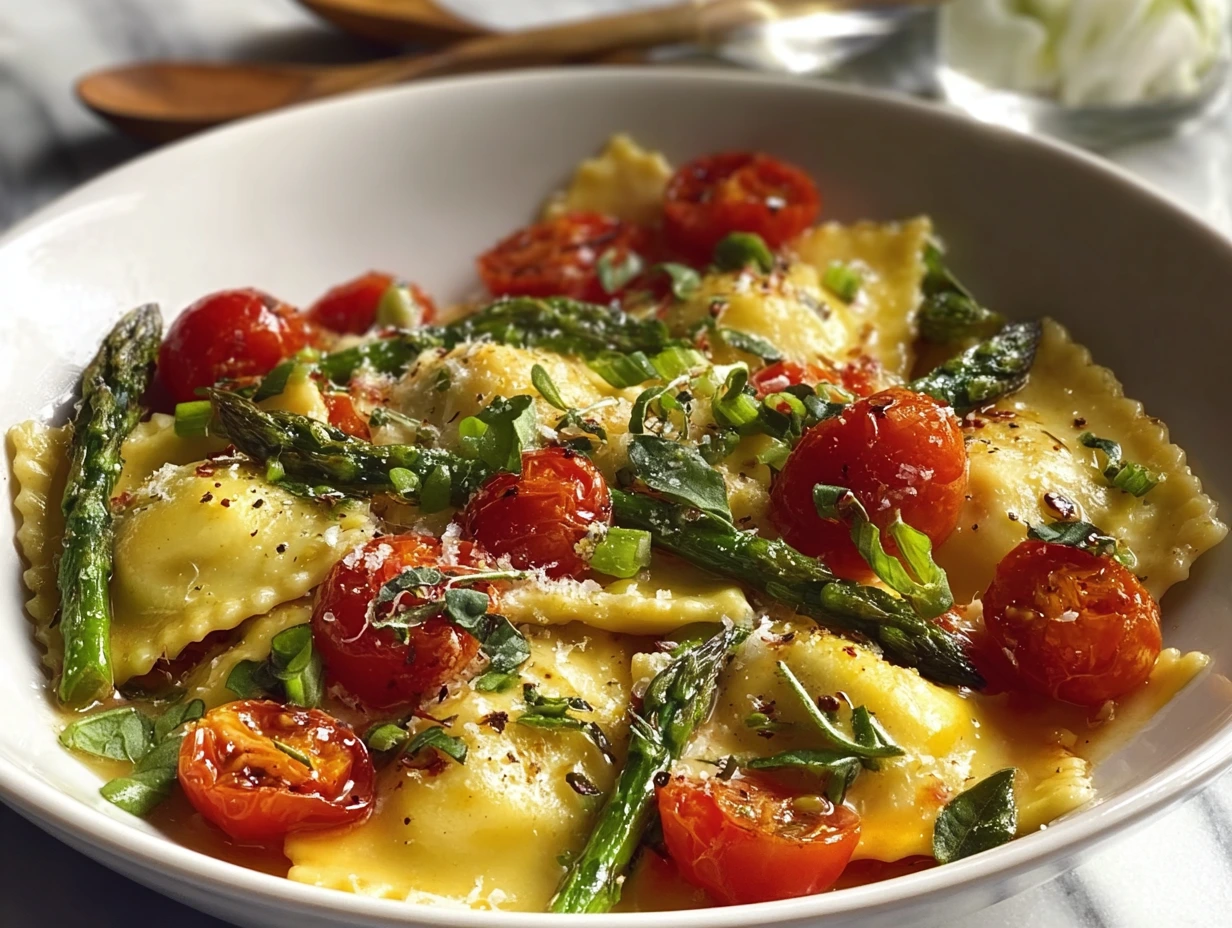
STEP 6: Finish with Parmesan and Serve
Now for the best part—cheese. Sprinkle about ½ cup of freshly grated Parmesan into the skillet and gently fold it through the ravioli and veggies. The heat from the pan will start to melt the cheese into the light sauce, giving everything a delicious savory edge.
Divide the ravioli among warm plates or a shallow serving bowl, and don’t be shy with an extra sprinkle of Parmesan right before serving. The cheese melts slightly on contact and brings out all the earthy, herby flavors in the dish.
Serve immediately while everything is warm and vibrant. I like to pair it with a crisp white wine or a sparkling water with lemon if I’m keeping it light. Add a slice of crusty bread and maybe a green salad, and you’ve got yourself a full meal that feels like a little celebration.
Variations and Helpful Tips
Here are a few quick tweaks and pro tips if you want to make this dish your own or stretch it for another occasion:
-
Switch up the herbs – Fresh basil is lovely, but parsley, oregano, or even a little mint would be great here. Go with what’s in season or what’s in your fridge.
-
Add a touch of cream – For a richer, more luxurious sauce, stir in a splash (1–2 tablespoons) of heavy cream at the end. It blends beautifully with the Parmesan and makes the sauce a little more decadent.
-
Try a different pasta – Don’t have ravioli on hand? You can use tortellini or even plain pasta like penne or farfalle. The sauce and veggies work with just about anything.
-
Use what you have – No asparagus? Sub in green beans, zucchini, or even spinach. This is a very flexible recipe, and it’s great for cleaning out your produce drawer.
-
Make it a meal – Add grilled chicken, shrimp, or white beans for extra protein if you want to bulk things up.
This dish is all about embracing seasonal ingredients and making something delicious with minimal effort. You’ll be surprised how fancy it feels for how little work it takes.
Your Ravioli Questions, Answered + Final Thoughts
We’ve cooked, sautéed, tossed, and garnished—by now, your kitchen probably smells amazing, and hopefully you’re already enjoying a warm plate of this light and flavorful Ravioli with Tomatoes, Asparagus, Garlic, and Herbs. But before we wrap things up, let’s talk about a few common questions that tend to pop up with this kind of dish.
Whether it’s about substitutions, leftovers, or getting that sauce just right, I’ve got you covered. Here’s a quick FAQ to help make sure your next batch turns out just as great.
Frequently Asked Questions
1. Can I use frozen ravioli instead of fresh or refrigerated?
Yes, frozen ravioli works just fine in this recipe. Just add a couple of extra minutes to the boiling time and make sure to cook them until they float and are tender. No need to thaw them first—straight from freezer to pot is perfect.
2. What’s the best way to reheat leftovers?
Leftovers are best reheated gently in a skillet over medium-low heat. Add a splash of water or a little extra butter to help revive the sauce and prevent the ravioli from drying out. Microwave reheating works in a pinch, but the skillet method keeps the texture nicer.
3. Can I make this dish ahead of time?
You can prep parts of it ahead—like cutting the veggies or even boiling the ravioli and tossing them with a bit of olive oil to keep them from sticking. But for the best texture and flavor, I recommend sautéing and assembling everything just before serving.
4. What proteins pair well with this dish?
Grilled chicken, shrimp, or even pan-seared scallops are all great additions. You could also toss in white beans or chickpeas if you want to keep it vegetarian but add some protein.
5. Can I make this dairy-free or vegan?
You can! Just use dairy-free ravioli (they’re more widely available than you might think), swap the butter for more olive oil, and use a vegan Parmesan substitute or nutritional yeast for that cheesy finish.
6. What other veggies could I use instead of asparagus?
This recipe is super flexible. Try zucchini, green beans, spinach, kale, or even mushrooms. Just adjust cooking times based on the veggie you choose—firmer vegetables will need a few more minutes to soften.
7. What’s chiffonade, and do I have to do it?
Chiffonade is a fancy word for slicing herbs like basil into thin ribbons. It looks pretty and helps release the aroma, but if you’re short on time, just tear the basil leaves roughly and toss them in. It’ll still taste amazing.
Final Thoughts and Serving Ideas
There’s something incredibly satisfying about a recipe that comes together in 20 minutes, looks beautiful on the plate, and feels like it came straight out of a cozy bistro. This Ravioli with Tomatoes, Asparagus, Garlic, and Herbs is that kind of recipe. It’s a little rustic, a little elegant, and full of bright, seasonal flavor.
I love serving this on a casual weeknight when I want something more exciting than takeout, but it also works beautifully for brunch, lunch with friends, or even a springtime dinner party. Add a simple green salad with lemon vinaigrette and a loaf of warm bread, and you’ve got a meal that’s ready to impress—without a lot of effort.
And the best part? This recipe is endlessly customizable. Use whatever pasta or vegetables you have on hand, switch up the herbs based on your garden or grocery haul, and don’t be afraid to experiment. It’s a great way to bring a little freshness and creativity into your kitchen.
PrintRavioli with Tomatoes, Asparagus, Garlic, and Herbs
Delicate cheese-filled ravioli are tossed with bright cherry tomatoes, tender asparagus, and fragrant garlic in a light herb-infused olive oil. A finish of fresh basil and a sprinkle of Parmesan makes this simple pasta dish feel fresh, spring-worthy, and satisfying all at once.
- Author: Mark's Recipe
Ingredients
For the pasta
1 pound fresh or refrigerated cheese ravioli
For the vegetable sauté
2 tablespoons extra-virgin olive oil
2 tablespoons unsalted butter
3 garlic cloves, thinly sliced
1 pint cherry tomatoes, halved
1 bunch asparagus (about 8 ounces), trimmed and cut into 1-inch pieces
Salt and freshly ground black pepper to taste
Pinch of red pepper flakes (optional)
For finishing and garnish
¼ cup fresh basil leaves, chiffonade
1 tablespoon fresh thyme leaves (or 1 teaspoon dried)
½ cup freshly grated Parmesan cheese, plus more for serving
Zest of one lemon (optional)
Instructions
Bring a large pot of salted water to a gentle boil and cook the ravioli just until they float and are al dente. Use a slotted spoon to transfer them directly into the skillet, reserving a cup of pasta cooking water.
Meanwhile, in a large skillet over medium heat, warm the olive oil and butter until the butter foams. Add the sliced garlic and sauté for about thirty seconds, until fragrant but not browned. Stir in the asparagus pieces and cook for two to three minutes, until they begin to soften. Add the cherry tomato halves, season with salt, pepper, and red pepper flakes if using, and cook until the tomatoes start to release their juices, about three minutes more.
Gently add the cooked ravioli to the skillet, tossing to coat in the tomatoes and asparagus. If the pan seems dry, add a splash of the reserved pasta water to create a light sauce. Remove from heat and stir in the fresh basil, thyme leaves, and lemon zest if desired.
Divide the ravioli among warm plates or a shallow serving bowl. Sprinkle each portion generously with grated Parmesan and serve immediately while the flavors are vibrant and the cheese is melting.
Notes
For extra depth, deglaze the pan with a splash of dry white wine after the garlic and let it reduce before adding asparagus.
Swap basil for fresh parsley or oregano for a different herb profile.
If you’d like more sauce, stir in two tablespoons of heavy cream or a knob of butter at the end.
Leftovers keep in an airtight container in the refrigerator for up to two days; reheat gently in a skillet with a little water to revive the sauce.
